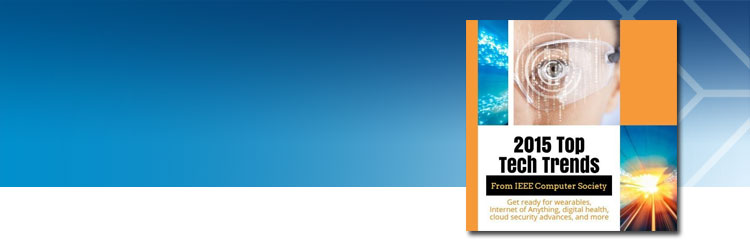Sign in

Please check your email address and password.
Navigation |
Top Technology Trends for 2015by IEEE Computer Society Top Technology Trends for 2015IEEE Computer Society announced the top 10 most important technology trends for 2015 and explores how these technologies will be integrated into daily life.In the coming year, while consumers will be treated to a dizzying array of augmented reality, wearables, and low-cost 3D printers, computer researchers will be tackling the underlying technology issues that make such cutting-edge consumer electronics products possible. Cybersecurity in general will remain a critical concern, with increased focus on security for cloud computing and deeply embedded devices. And interoperability and standards will be top priorities to unleash the potential of Software-defined Anything (SDx) and the Internet of Anything (IoA). "Researchers have been working to address these issues for a number of years, however 2015 should see real progress in these areas," said incoming IEEE Computer Society President Thomas Conte, an electrical and computer science professor at Georgia Tech. "We are reaching an inflection point for 3D printing, which will revolutionize manufacturing, and the exponential growth in devices connected to the Internet makes interoperability and standards critical." Among the advances that IEEE Computer Society experts forecast: 1) The time is right for wearable devicesImagine a wearable device that tells time, sends and receives email and messages, makes calls, and even tracks exercise routines. Smartwatches hitting the market do all that and more. Both established players and small startups in 2015 will be actively involved in developing new devices, applications, and protocols for the wearable electronics market. 2) Internet of Anything will become all-encompassingThe reality that up to 26 billion things will be connected on the Internet by 2020 is sinking in. The Internet of Things and Internet of Everything in 2015 will morph into the Internet of Anything. IoA envisions a common software "ecosystem" capable of accommodating any and all sensor inputs, system states, operating conditions, and data contexts — an overarching "Internet Operating System." 3) Building security into software designAs the volume of data explodes, along with the means to collect and analyze that information, building security into software design and balancing security and privacy are becoming top priorities. 4) Industry will tackle Software-defined Anything (SDx) interoperability and standardsSoftware-defined networking's programmability will turn various network appliances into a warehouse of apps. Several standards groups are working on interoperability issues, including the Open Networking Foundation (ONF), the Internet Engineering Task Force (IETF), the European Telecommunications Standards Institute (ETSI), and the International Telecommunication Union (ITU). 5) Cloud security and privacy concerns growThe celebrity photo hacking scandal and iCloud breach in China in 2014 has brought cloud security to the forefront for 2015. Enterprises are moving workloads to the cloud and expecting enterprise-level security. To avoid system fragility and defend against vulnerabilities exploration from cyber attackers, various cybersecurity techniques and tools are being developed for cloud systems. 6) 3D Printing is poised for takeoffNext year will see production of the first 3D-printed car. The 3D-printed car is just one of hundreds of uses that enterprises and consumers are finding for 3D printing, which will revolutionize manufacturing by lowering costs and time to market. Also in 2015, sales of 3D printers are expected to take off, driven by low-cost printing and uptake by a variety of industries. 7) Predictive Analytics will be increasingly used to identify outcomesBusiness intelligence in 2015 will be less about examining the past and more about predicting the future. While predictive modeling techniques have been researched by the data mining community for several decades, they are now impacting every facet of our lives. In organizational settings, predictive analytics has gained widespread adoption over the past decade as firms look to compete on analytics. 8) Embedded Computing security will get added scrutinyDeeply-embedded computing systems often perform extremely sensitive tasks, and in some cases, such as healthcare IT, these are lifesaving. Emerging deeply-embedded computing systems are prone to more serious or life-threatening malicious attacks. These call for revisiting traditional security mechanisms not only because of the new facets of threats and more adverse effects of breaches, but also due to the resource limitations of these often-battery-powered and extremely constrained computing systems. 9) Augmented Reality Applications will grow in popularityMobile apps using augmented reality help the colorblind see colors, travelers explore unfamiliar cities, shoppers imagine what they look like in different outfits, and even help drivers locate their parked cars. The availability of inexpensive graphics cards and sensors, and the popularity of applications in such areas as gaming and virtual worlds, is bringing augmented reality into the mainstream. 10) Smartphones will provide new opportunities for Continuous Digital HealthThe way we deal with our health is undergoing a major transformation, not only because mobile Internet technology has made it possible to have continuous access to personal health information, but also because breaking the trend of ever-growing healthcare costs is increasingly necessary. Connectivity, interoperability, sensing, and instant feedback through smartphones all provide new opportunities for gaining insights into our health behavior. Source: IEEE Computer Society
|